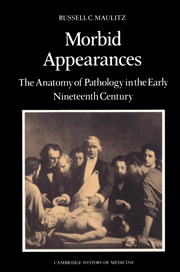Book contents
- Frontmatter
- Contents
- Dedication
- Preface
- Introduction: Ouverture: Bichat's head
- PART ONE PARIS
- 1 Genesis of a tradition
- 2 Pathology and the Paris faculty
- 3 Pathology in the middle
- 4 The center holds
- PART TWO CHANNEL CROSSING
- PART THREE LONDON
- Conclusion: A language of morbid appearances
- Appendix: Transcription and translation of Figure 1.1
- Notes
- Selected bibliography
- Index
4 - The center holds
Published online by Cambridge University Press: 22 September 2009
- Frontmatter
- Contents
- Dedication
- Preface
- Introduction: Ouverture: Bichat's head
- PART ONE PARIS
- 1 Genesis of a tradition
- 2 Pathology and the Paris faculty
- 3 Pathology in the middle
- 4 The center holds
- PART TWO CHANNEL CROSSING
- PART THREE LONDON
- Conclusion: A language of morbid appearances
- Appendix: Transcription and translation of Figure 1.1
- Notes
- Selected bibliography
- Index
Summary
On arriving in Paris in 1822 with my condisciple A. Robert, I gave myself entirely to the studies for the career that was imposed on me …. Robert, having apprised me one morning that he had bought a subject (a cadaver), took me for the first time to the dissection amphitheater at the hospice de la Pitié. The sight of that horrid human charnel-house, those scattered limbs, those grimacing heads, those half-cracked skulls, the bloody cesspool in which we walked, the revolting odor pouring out, the swarms of birds fighting over scraps of lung, the rats in their corner gnawing on bloody vertebra, filled me with such dread that, jumping from the amphitheater window, I took flight and ran home all out of breath, as though death and her hideous procession were at my heels.
– Hector Berlioz (1803–1869), Mémoires.ATTEMPTS TO DISARTICULATE MEDICINE AND SURGERY
Throughout the Napoleonic period Michel Thouret, the Paris faculty's director and later dean, would have to struggle, alongside his patron Antoine Fourcroy and his lieutenant François Chaussier, to keep the institution they had crafted on course. Avid republicans all, these men formed its core, provided its ballast. They fought, as did Thouret's successor J. J. Leroux after the first director – dean's 1810 death, to preserve their creation against a series of revanchists.
- Type
- Chapter
- Information
- Morbid AppearancesThe Anatomy of Pathology in the Early Nineteenth Century, pp. 83 - 106Publisher: Cambridge University PressPrint publication year: 1987



